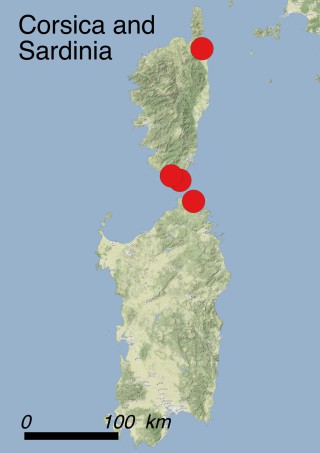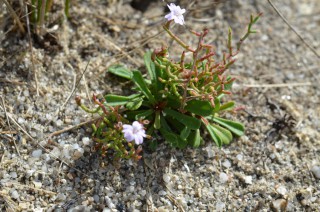Where it is found ?
Endemic to Corsica and Sardinia, Limonium strictissimum only grows in coastal areas. In Sardinia it grows in a single location on the granitic rocks of Punta Rossa in the islet of Caprera (Maddalena Archipelago), where only few dozen individuals are known up to date. In Corsica L. strictissimum shows a wider ecological amplitude, being able to colonize the wet sands near water bodies (habitat 13.4: Coastal brackish-saline Lagoons/Marine Lakes), more or less coarse sand shores (habitat 13.3: Coastal sand dunes) and calcareous sediments, coastal calcareous and granitic cliffs (habitat 13.1: Sea cliffs and Rocky Offshore Islands). Corsica hosts 1,000-1,500 individuals, which form approximately 10 small populations scattered along the SW coast (Poggio di Roto, Pointe de Capi Neru), in the municipality of Bonifacio (Cala Ciappili, Piantarella, SE shore of the Gulf of Sant’Amanza, Maora beach, cliffs of Ricetti and Rocchi Bianchi, Cavallo islet), and near the outlet of the lagoon of Biguglia in the municipality of Furiani (site of Banda Bianca).
How to recognize it ?
The erect stems of this dwarf woody plant grow up to 30 cm tall. The leaves, imbricate and clumped at the base of the stem, lineate or spathulate, 1,5 to 2,5 cm long and 0,2 to 0,4 cm wide, are often covered with debris of sea grass (Posidonia oceanica) leaves accumulated by wind and sea currents. In summer, mostly in August, 10 to 30 cm long erect twig-like leafless inflorescences grow up bearing very small blue-pink tubular flowers. The overall habit of the plants is strongly influenced by environmental conditions; as a rule, the individuals growing on incoherent substrata are larger and more numerous than those growing on rocky cliffs because they enjoy higher water availability.
Interesting facts
The genus Limonium includes a very high number of taxa (many hundreds along the Mediterranean coasts only) which are often hard to distinguish one from the other. More in detail, L. strictissimum belongs to the Limonium articulatum (2n=18) group (whose species are distributed throughout the rocky coasts of Corsica). Although being a triploid species (2n=27), like most sea-lavenders, Limonium strictissimum is able to produce seeds without flower pollination through a mechanism called apomixis.
Why is it threatened ?
This plant has been recently assessed as Endangered at regional level in Corse and as Vulnerable in Sardinia (even if it counts only 50 mature individuals, the single population of Caprera island is experiencing a positive demographic trend). Considering the available data concerning both islands, L. strictissimum can be categorized as EN (Endangered) at global level according to IUCN Red List criteria B2ab(iii), because the AOO is equal to 32 km2, the number of locations is >5 and the plant species as well as the habitat quality recently experienced a continuous decline. The species is threatened with natural disturbance factors such as rockfall (threat 10.3: Avalanches/Landslides), competition by co-occurring plants like Carpobrotus edulis and Spartina patens (threat 8.1.2: Invasive non-native/alien species - Named species) and Elytrigia acuta (threat 8.2.2: Problematic native species/diseases - Named species) and seasonal drought stress (threat 11.2: Drought). Anthropogenic disturbance in particular seaside trampling by tourists and by 4x4 vehicles linked to summer tourism (threat 6.1: Recreational activities) also represents a threat, as well as the possible construction of touristic buildings (threat 1.3: Tourism & recreation areas), especially on Maora beach.
The most abundant (750-800 individuals over an area of ca. 300-400 m2) and healthy population is located on a sandy strip near Piantarella Lagoon, a site that is still neither protected by national laws nor proposed to be included within Natura 2000 network, which was closed for protection by the RNBB (Réserve Naturelle-des-Bouches-de-Bonifacio) in 2015.
What has been done to protect it ?
Legally: the species is protected at a national level by the French Law (decree of 20 January 1982, amended August 31, 1995) and at an international level the species is listed among the priority species within Annexes II and IV of 92/43 European ‘Habitat’ Directive.
One of the subpopulations grows within the SCI FR940057 ‘Etang de Biguglia’.
The Sardinian subpopulation falls within the National Park ‘Arcipelago di La Maddalena’ and in the Natura 2000 SCI ITB100008 ‘Arcipelago Maddalena’.
While waiting for a national action plan to be realised, a recent overview allowed to gather all available information on the species, assessing its area of occurrence (<5 ha), the status of all populations up to 2013, identifying the main threats and the most urgent conservation measures.
In situ: the population of Caprera island (Sardinia) falls within the National Parc of ‘Arcipelago di La Maddalena’. The Conservatoire du littoral (Cdl) is the owner of the site hosting the population of Banda Bianca near the outlet of the lagoon of Biguglia, and the Département de la Haute-Corse is officially responsible for the management of the site. In 2000 the Cdl carried out several interventions in order to protect the local population of L. strictissimum from trampling by tourists and 4x4 vehicles. Additionally, Carpobrotus edulis was totally eradicated from the area, but due to the lack of subsequent monitoring activities, L. strictissimum is threatened with the ongoing evolution of local plant communities due to the faster spread of more competitive species such as Spartina patens and Elytrigia acuta which reproduce vegetatively or Carpobrotus edulis producing a huge seed bank. This fact induced a severe reduction of the local population of L. strictissimum, and in 2016, it is nearly extinct.
Ex situ: Neither seeds nor adult plants of L. strictissimum are conserved ex situ. Seed collection from all Corsican subpopulations will be performed by the National Botanical Conservatory of Corsica during 2017.
Which conservation actions are needed ?
In order to perform an effective conservation strategy for L. strictissimum, the following six actions should be carried out: to monitor all the subpopulations, to manage all the sites affected by tourism-related activities, to publish biotope protection prefectural orders (APPB) on the sites which are subject to high anthropogenic pressure, to start an effective management of the sites, particularly urgent for Banda Bianca, to collect and store seeds from all populations for ex situ conservation initiatives, and to improve the control of the sites through ownership (as already started by Cdl through purchasing initiatives).
Scientific coordination
Dr. Guilhan Paradis, Ajaccio, France
Carole Piazza, Conservatoire botanique national de Corse, Office de l’Environnement de la Corse, Corte, France
Giuseppe Fenu, Centro Conservazione Biodiversità, Dipartimento di Scienze della Vita e dell’Ambiente, Università degli Studi di Cagliari, Viale Sant’Ignazio da Laconi 13, 09123 Cagliari, Italy.
Donatella Cogoni, Centro Conservazione Biodiversità, Dipartimento di Scienze della Vita e dell’Ambiente, Università degli Studi di Cagliari, Viale Sant’Ignazio da Laconi 13, 09123 Cagliari, Italy.
Gianluigi Bacchetta, Centro Conservazione Biodiversità, Dipartimento di Scienze della Vita e dell’Ambiente, and Hortus Botanicus Karalitanus (HBK), Università degli Studi di Cagliari, Viale Sant’Ignazio da Laconi 9 -11, 09123 Cagliari, Italy.
Photos
Dr. Guilhan Paradis, Ajaccio, France



